 W
WIn annelids, elytra are shield-like scales that are attached dorsally, one pair on each of a number of alternating segments and entirely or partly cover the dorsum. Elytra are modified dorsal cirri, and their number, size, location, and ornamentation are important taxonomic characters. The basal part of the elytra is known as the elytrophore; if elytra are lost their presence is indicated by the elytrophore which is still present and visible.
 W
WThe Polychaeta, also known as the bristle worms or polychaetes, are a paraphyletic class of annelid worms, generally marine. Each body segment has a pair of fleshy protrusions called parapodia that bear many bristles, called chaetae, which are made of chitin. More than 10,000 species are described in this class. Common representatives include the lugworm and the sandworm or clam worm Alitta.
 W
WSpirobranchus cariniferus, commonly known as the blue tubeworm or spiny tubeworm, or by its Māori name toke pā, is a species of tube-building polychaete worm endemic to New Zealand.
 W
WAmphinomida is an order of marine polychaetes. The order contains two families:Amphinomidae Lamarck, 1818 Euphrosinidae Williams, 1852
 W
WAmphinomidae, also known as the bristle worms or sea mice, are a family of marine polychaetes, many species of which bear chaetae mineralized with carbonate. The best-known amphinomids are the fireworms, which can cause great pain if their toxin-coated chaetae are touched or trodden on. Their relationship to other polychaete groups is somewhat poorly resolved.
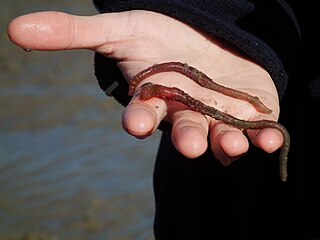 W
WArenicola is a genus of capitellid annelid worm comprising the lugworms and black lugs.
 W
WArenicolidae is a family of marine polychaete worms. They are commonly known as lugworms and the little coils of sand they produce are commonly seen on the beach. Arenicolids are found worldwide, mostly living in burrows in sandy substrates. Most are detritivores but some graze on algae.
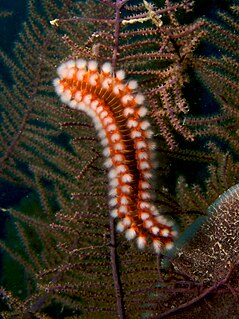 W
WThe bearded fireworm is a type of marine bristleworm belonging to the Amphinomidae family, native to the tropical Atlantic Ocean and the Mediterranean Sea.
 W
WBiomineralising polychaetes are polychaetes that biomineralize.
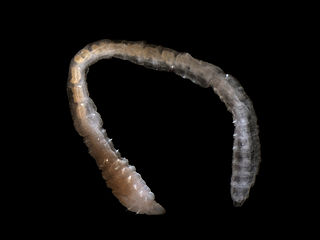 W
WCapitella capitata is a polychaete worm that grows up to 10 cm in length. It is often blood-red in colour. The species is sedentary and fragile, with a flexible body.
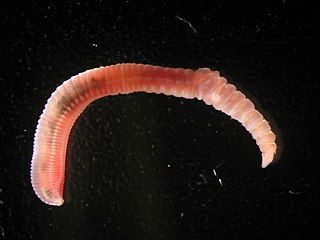 W
WCapitella teleta is a small, cosmopolitan, segmented annelid worm. It is a well-studied invertebrate, which has been cultured for use in laboratories for over 30 years. C. teleta is the first marine polychaete to have its genome sequenced.
 W
WCapitellidae is a polychaete worm family in the subclass Scolecida.
 W
WDinophilidae is a family of annelids of uncertain phylogenetic affinity comprising the two genera Dinophilus and Trilobodrilus, first linked based on their sperm morphology.
 W
WDinophilus taeniatus is a small annelid worm which lives in tidal pools. It is 1.5 – 2.5 mm long and about 150 µm wide, orange in colour, with two distinct dark pigmented eyes on its prostomium. The anterior part of prostomium has four large and many small bristles and sensory cilia. The trunk consist of 11 rings where the first nine rings are distinctly separate. The ventral trunk is densely covered with cilia. It is widely distributed around the UK coast, from the Irish Sea through to the Barents Sea.
 W
WHaplodrili, or Archiannelida, is an order of primitive polychaete worms. Zoologist Ray Lankester gave it the name haplodrili, while zoologist Berthold Hatschek later named it Archiannelida. Once considered to be a class under Annelida, and even a separate phylum, Haplodrili is now widely accepted to be an order under Polychaeta. Species in this order are known for completely lacking external segments.
 W
WThe lugworm or sandworm is a large marine worm of the phylum Annelida. Its coiled castings are a familiar sight on a beach at low tide but the animal itself is rarely seen except by those who, from curiosity or to use as fishing bait, dig the worm out of the sand.
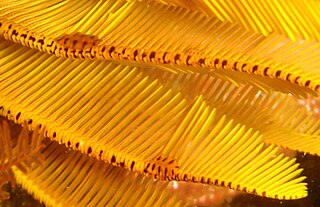 W
WMyzostoma is a genus of marine worms, which are which are parasitic on crinoids in the family Myzostomidae.
 W
WMyzostoma fuscomaculatum, the crinoid worm, is a species of marine worm in the family Myzostomida.
 W
WThe Myzostomida or Myzostomatida are an order of small marine worms, which are parasitic on echinoderms, mostly crinoids. These highly unusual and diverse annelids were first discovered by Friedrich Sigismund Leuckart in 1827.
 W
WThe Nerillidae are a family of invertebrates containing these genera:Meganerilla Mesonerilla Nerilla Nerillidium Nerillidopsis Paranerilla Psammoriedlia Thalassochaetus Troglochaetus
 W
WOphelliidae is a family of small, annelid worms. It contains the following genera:Ammotrypanella Antiobactrum Armandia Dindymenides Euzonus Kesun Lobochesis Ophelia Ophelina Polyophthalmus Pygophelia Tachytrypane Thoracophelia Travisia
 W
WOphelina acuminata is a species of marine annelids, found in the sublittoral mud and sand bottom.
 W
WOphryotrocha is a genus of marine polychaete worms in the family Dorvilleidae.
 W
WOphryotrocha puerilis is a species of marine polychaete worms in the order Eunicida. It is native to the northern Atlantic Ocean and the Mediterranean Sea and is the type species of the genus Ophryotrocha.
 W
WOrbiniidae is a family of polychaete worms. Orbiniids are mostly unselective deposit feeders on marine detritus. They can be found from the neritic zone to abyssal depths.
 W
WPalola viridis, commonly known as the palolo worm, Samoan palolo worm, wawo or nyale, is a Polychaeta species from the waters of some of the Pacific islands, including Samoa, Vanuatu, and the islands of the Malaysian Archipelago.
 W
WPalpata is a subclass of polychaete worm. Members of this subclass are mostly deposit feeders on marine detritus or filter feeders. Palpata has become superfluous with the elevation of Canalipalpata to subclass.
 W
WPhragmatopoma californica, commonly known as the sandcastle worm, the honeycomb worm or the honeycomb tube worm, is a reef-forming marine polychaete worm belonging to the family Sabellarididae. It is dark brown in color with a crown of lavender tentacles and has a length of up to about 7.5 centimeters (3.0 in). The worm inhabits the Californian coast, from Sonoma County to northern Baja California.
 W
WPhragmochaeta canicularis is an extinct animal belonging to the annelids and lived in the Early Cambrian. Fossils have only been found in the Buen Formation at the Sirius Passet Lagerstätte, Greenland and the animal is probably the first polychaete.
 W
WPhyllodoce lineata is a species of polychaete worm in the family Phyllodocidae. It is native to the northeastern Atlantic Ocean and the Mediterranean Sea where it occurs in the intertidal and shallow sub-tidal zones on soft sediment.
 W
WPhyllodoce maculata is a species of Polychaete worm in the family Phyllodocidae. It is native to the northeastern Atlantic Ocean where it inhabits shallow water areas of sand, mud and stones.
 W
WPhyllodoce mucosa is a species of polychaete worm in the family Phyllodocidae. It is found intertidally in both the Pacific and Atlantic Oceans, typically on sandy or muddy seabeds.
 W
WPhyllodocidae is a family of polychaete worms. Worms in this family live on the seabed and may burrow under the sediment.
 W
WPilargidae is a family of polychaetes. These marine worms are cylindrical, somewhat flattened, and can be ribbon-like. They can be found free-living on sediment, or shallowly in sediment. Some species within the genera Hermundura and Litocorsa are known to burrow, having reduced heads and parapodia. Two species are known to be commensal with other polychaetes. Pilargis berkeleyae will live in the tubes of Chaetopteridae, and Ancistrosyllis commensalis will live in Capitellidae burrows. Pilargid worms are almost all exclusively predators, classified as carnivore omnivores. They are similar in appearance to Hesionidae, with a peristomium often with two pairs of tentacular cirri, reduced or absent notopodia, and a lack of pharyngeal jaws. The first few segments bearing setigers are also somewhat fused. They can have 0 to 3 antennae, and palps. These polychaetes are rarely the most abundant polychaete.
 W
WPolydora ciliata is a species of annelid worm in the family Spionidae, commonly known as a bristleworm. It is a burrowing worm and is found in the northeastern Atlantic Ocean and some other parts of the world.
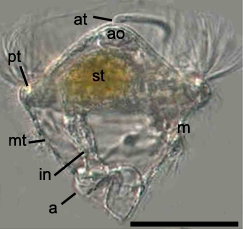 W
WPomatoceros lamarckii is a species of tube-building annelid worms which is widespread in intertidal and sub-littoral zones around the United Kingdom and northern Europe. They are found attached to firm substrates, from rocks to animal shells to man made structures, and often are noted for their detrimental effect on shipping. It is closely related to, and often confused with, Pomatoceros triqueter.
 W
WPomatoceros triqueter is a species of tube-building annelid worm in the class Polychaeta. It is common on the north eastern coasts of the Atlantic Ocean and in the Mediterranean Sea.
 W
WPsammodrilus balanoglossoides is a species of meiofaunal polychaete annelid only found in France and the North Sea, it is one of the five species representing the genus Psammorilus.
 W
WA radiole is a heavily ciliated feather-like tentacle found in highly organized clusters on the crowns of Canalipalpata. Canalipalpata is an order of sessile marine polychaete worms consisting of 31 families. These benthic annelid tube worms employ radioles primarily for alimentation. While their primary role is to function as an organ for filter feeding, radioles also serve as respiratory organs. Because of their role in gas exchange, radioles are often referred to as "gills".
 W
WScalibregma inflatum, also known as T headed worm, is a burrowing marine polychaete. It is a cosmopolitan species that can be found from the Arctic to Antarctica, although most probably several species are confounded.
 W
WScolecida is an infraclass of polychaete worms. Scolecids are mostly unselective deposit feeders on marine detritus.
 W
WScolelepis squamata is a species of polychaete worm in the family Spionidae. It occurs on the lower shore of coasts on either side of the Atlantic Ocean.
 W
WSiphonostomites hesionoides is a species of polychaete annelid known only from subtidal lagoon deposits from the Early Eocene of Monte Bolca, Verona, Italy.
 W
WStreblospio benedicti is a small polychaete native to the Western Atlantic, where its distribution ranges from the Gulf of Saint Lawrence to Venezuela. Sexual maturity is reached at around 9 to 14 weeks and populations and individuals may vary during development. It can be found in the mudflats and soft sediments of estuaries and coastal waters. Its general habitat includes oyster reefs, mangroves, grass beds, marinas, and docks while the tidal range where S. benedicti can be found is subtidal to intertidal. Additionally, S. benedicti can tolerate a broad range of temperatures and salinities. Due to its tolerance of high organic contents, S. benedicti is a pioneer organism of new habitats that it settles in. Furthermore, despite its small size, only reaching a maximum of 20 mm (0.79 in) in length, S. benedicti plays an important role in estuarine food webs as it can reach high population densities and is a substantial grazer of phytoplankton.